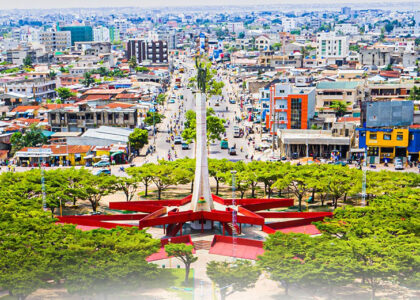Exploring the Administrative Structure of Benin: The 12 Departments and Their Communes
Benin, a beautiful and culturally rich country in West Africa, is administratively divided into 12 regions known as “departments.” These departments serve as the primary administrative divisions, each contributing uniquely to the country’s governance, culture, and economy. Below, we’ll explore each of these departments and explain how they are further divided into smaller administrative units called “communes.”
Understanding Benin’s Administrative Divisions
The 12 departments in Benin provide an organized framework for local governance and development. Each department is further divided into communes, which are the next level of administrative division. These communes function as local government areas, managing local affairs, providing public services, and ensuring that the unique needs of each community are met. There are a total of 77 communes across the country, each playing a vital role in the administration of their respective departments.
Let’s take a closer look at the 12 departments of Benin:
-
Alibori
Located in the northeastern part of Benin, Alibori is the largest department by area. It is known for its rich cultural heritage and natural attractions, including national parks and wildlife reserves. The department is primarily agricultural, with a strong emphasis on farming and livestock rearing. The department’s capital is Kandi, and it comprises six communes: Banikoara, Gogounou, Kandi, Karimama, Malanville, and Segbana. -
Atacora
Atacora, situated in the northwest, is characterized by its mountainous terrain and unique cultural diversity. It is home to the Atakora mountain range and several traditional communities that preserve their unique ways of life. The department’s capital is Natitingou. Atacora is divided into nine communes: Boukoumbé, Cobly, Kérou, Kouandé, Matéri, Natitingou, Pehunco, Tanguiéta, and Toucountouna. -
Atlantique
Atlantique is located in the south of Benin, bordering the Atlantic Ocean. It is one of the most economically significant departments due to its proximity to the country’s largest city, Cotonou. The department is an important hub for trade, commerce, and industry. The capital of Atlantique is Allada, and it is composed of eight communes: Abomey-Calavi, Allada, Kpomassè, Ouidah, Sô-Ava, Toffo, Tori-Bossito, and Zè. -
Borgou
Situated in the central-eastern part of Benin, Borgou is known for its diverse cultures and traditions, as well as its agricultural productivity. The department is a key area for crop production, particularly cotton, maize, and yam. The capital of Borgou is Parakou, and it is divided into eight communes: Bembèrèkè, Kalalè, N’Dali, Nikki, Parakou, Pèrèrè, Sinendé, and Tchaourou -
Collines
As the name suggests, Collines (which means “Hills” in French) is a department characterized by its hilly terrain. Located in central Benin, it is known for its scenic landscapes and rich biodiversity. Dassa-Zoumé serves as the capital of the department. Collines consists of six communes: Bantè, Dassa-Zoumé, Glazoué, Ouessè, Savalou, and Savè. -
Couffo
Couffo is a small department in the southwestern part of Benin, known for its agriculture, especially the cultivation of palm oil, maize, and cassava. The capital of Couffo is Aplahoué. The department is made up of six communes: Aplahoué, Djakotomey, Dogbo, Klouékanmè, Lalo, and Toviklin. -
Donga
Located in the northwest, Donga is known for its mixed vegetation, ranging from savannah to forested areas. It is an important agricultural area, with crops like yams, maize, and cotton. The department’s capital is Djougou. Donga comprises four communes: Bassila, Copargo, Djougou, and Ouaké. -
Littoral
Littoral is the smallest department by area but one of the most significant economically and administratively. It consists solely of the city of Cotonou, Benin’s largest city and economic capital. This department is a hub for international trade, commerce, and services, due to its seaport and proximity to the Atlantic Ocean. -
Mono
Situated in the southwestern part of Benin, Mono is known for its vibrant culture and historical significance. The capital is Lokossa. This department is characterized by its rich natural resources, including lagoons and fertile lands for farming. Mono is divided into six communes: Athiémè, Bopa, Comè, Grand-Popo, Houéyogbé, and Lokossa. -
Ouémé
Located in southeastern Benin, Ouémé is an economically important department with a strong focus on fishing, agriculture, and commerce. The department’s capital is Porto-Novo, which is also the political capital of Benin. Ouémé comprises nine communes: Adjarra, Adjohoun, Aguégués, Akpro-Missérété, Avrankou, Bonou, Dangbo, Porto-Novo, and Sèmè-Podji. -
Plateau
Plateau is situated in the southeastern part of Benin and is known for its diverse culture and agricultural activities. The capital of Plateau is Pobè, and it includes five communes: Adja-Ouèrè, Ifangni, Kétou, Pobè, and Sakété. -
Zou
Zou is located in the central-southern part of Benin and is noted for its rich history, culture, and traditions. The department is an important area for agriculture, particularly in the production of maize, cassava, and vegetables. The capital of Zou is Abomey, a city with historical significance as the former capital of the Kingdom of Dahomey. Zou is divided into nine communes: Abomey, Agbangnizoun, Bohicon, Covè, Djidja, Ouinhi, Zagnanado, Za-Kpota, and Zogbodomey.
The Role of Communes in Local Governance
Communes in Benin are responsible for managing local administrative tasks, providing public services, and fostering local development. Each commune has its own council and mayor, who oversee local governance and development initiatives. This decentralized approach allows for greater community involvement in decision-making processes, ensuring that the unique needs and preferences of local populations are addressed.
Conclusion
Benin’s administrative structure, with its 12 departments and 77 communes, reflects a diverse and vibrant country that values local governance and community participation. Understanding the administrative divisions helps both locals and visitors appreciate the rich cultural diversity and the unique characteristics that each region brings to the nation. Whether you are planning a trip to Benin or are simply interested in learning more about this fascinating country, the departments and communes provide a fascinating insight into its administrative organization and regional distinctions.




